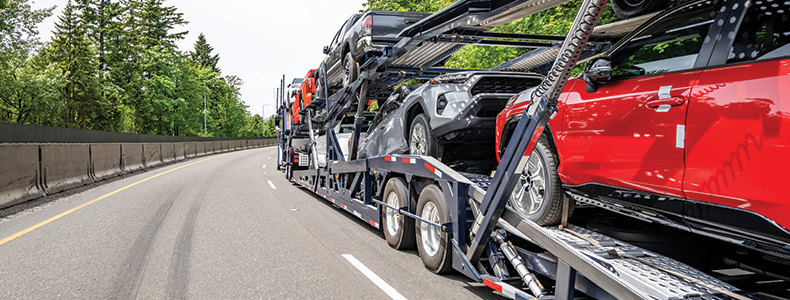Mother Nature follows her random calendar when bringing seasonal challenges in vehicle shipping. As you plan the perfect delivery for your classic Chevy’s long trip, she brews up a blizzard set to delay it for days. Before your show-ready Thunderbird ships out for summer events, she floods the route with impassable rainfall.
Battling unstable seasonal issues leaves even reliable transporters scrambling when timetables spiral out of control. Guaranteed arrival dates set in stone suddenly mean nothing when whiteout snows force trucks to stand still. And you wonder why your ride got stuck halfway instead of showing up on the set date.
At uShip, we know shipping through Mother Nature’s uncertainties requires flexibility and smart workarounds. We’ve moved thousands of vehicles all over the country, so our experience is a huge asset in keeping your vehicle safe in transport.
From finding new paths around rising floods to sheltering classics from summer heat waves, uShip provides confidence beyond what you might expect. Think of us as the all-weather tire to the industry’s worn versions — equipped to steer the toughest shipping voyages when elements seem against you.
The Impact of Summer on Vehicle Shipping
We know summer’s beautiful weather excites you to take road trips or buy that convertible you’ve been eyeing. But as a professional auto transport service moving thousands of vehicles yearly, warmer months bring challenges — overtaxed engines, overflowing demand, and strained drivers. These all perpetuate seasonal challenges in vehicle shipping!
While these issues are typical industry-wide, we proactively address them so your transport goes smoothly no matter how high the mercury climbs.
Preventing Overheating Headaches
Transporting vehicles is already taxing on parts like cooling systems. But excessive heat and fully loaded trucks laboring up steep highways push the limits. We install extra transmission coolers in our fleet and closely monitor temperatures. Drivers plan routes to avoid congestion during afternoon peak heat.
Still, summer breakdowns cost time and money. By keeping transport volumes reasonable per rig, checking fluid levels pre-transit, and disabling alarms prone to heat-triggered false alarms, we significantly lower the risks of delays due to overheating issues.
Managing Surging Demand
As a popular auto transport provider, our order volume often doubles between winter downtime and summer’s peaks. Vacationers need extra cars delivered, winter ice has more buyers demanding trucks and SUVs perfect for summer fun, and students require affordable cars for campus — all in a short window.
Winter Woes: Navigating Cold Weather Shipping

Snow-covered roads and icy conditions can lead to hazardous winter driving. But for auto transport carriers, heavily burdened trucks and near-freezing temps pose risks beyond slippery streets.
From managing road closures to preventing cargo damage, transporting vehicles in cold weather requires extensive planning to keep shipments on schedule through the season’s worst.
Delays from Closed Highways
Due to heavy snowfall, mountain passes, and rural routes often face complete winter shutdowns. These closures leave carriers balancing timing and efficiency with safety in navigating blocked corridors. Without caution, taking risky alternate trails or ignoring warnings can spell disaster.
Protecting Your Cargo from Freezing
Bitter overnight temperatures and high winds during transport can damage vehicle components and interiors. Truck cabs keep cargo from the worst exposure, leaving it vulnerable, especially on multi-car carriers.
uShip recommends customers have antifreeze levels inspected before winter shipping. We offer enclosed trailer transport for any vehicle immune to freezing and road debris.
Through weatherproofing preparations and equipment, we deliver every vehicle in flawless condition regardless of freezing temps.
Safety Above All Else
Snow-covered and icy roads significantly reduce available traction, increasing risks for industry-standard open equipment. But outsized or top-heavy vehicles require enclosed trailers unequipped for such hazards.
Attempting transport risks extensive damage and threatens everyone’s safety should conditions worsen further making seasonal challenges in vehicle shipping even harder.
Autumn Adjustments for Vehicle Shipping
Crisp air and vibrant foliage make autumn a captivating season. But, for vehicle transport, unpredictable fall conditions pose tricky navigation challenges. From gusty storms to leaf-slick roads, trucks, and cargo face harm without careful preparation, not to mention winter just around the corner.
Mitigating Fall Weather Worries
Weather-wise, Fall is a fickle interval, subject to extremes from one day to the next. Sunny skies easily spiral into blustery fronts or torrential rain. High winds batter transports, and saturated roads leave little leeway to avoid risks.
While schedule delays from fall storms still happen, attentive equipment maintenance and adaptable routing keep transports and cargo secure.
Handling Slippery Leaves
Vibrant red and orange foliage certainly makes for spectacular seasonal scenery. But as vibrant leaves die off, they also create real road hazards. Accumulating on surfaces, mushy leaves reduce traction and visibility.
Carriers equip transport trailers with all-weather tires to maximize grip. Drivers reduce speeds in leaf-prone zones and avoid matted stretches obscuring potholes. Though leaf troubles can’t be entirely prevented, the cautious operation ensures safe passage.
Gearing Up for Winter
Transporters invest extensive time transitioning fleets when autumn hits. Some carriers swap all-season tires for specialty winter ones with studs and chains. Fire extinguishers should be checked, and cargo areas can be winterized before freezing sets in. Robust inspection and maintenance prevent being caught unprepared when winter weather ultimately strikes.
We also suggest clients winterize vehicles before autumn shipping. This saves hassle later and protects against early cold snaps. Ensure antifreeze levels, battery life, fluid contents, and tire treads will withstand freezing conditions. Replace wipers and top off windshield wiper fluid, too.
While fall makes for a picturesque road trip setting, vehicle transport requires extra consideration when handling the season’s unique road variables. But attentive preparation and adapting to shifting conditions lets cars reach destinations damage-free. Trust us for solving seasonal challenges in vehicle shipping.
Tips To Save On Vehicle Shipping Services in All Seasons
Whether you’re moving cross-country or buying a vintage ride from a far-flung destination, professionally hauling a vehicle saves wear and tear on both the vehicle. But outsourced transport adds up, especially for specialty equipment like flatbeds, enclosed trailers, or extra insurance.
Luckily, several strategies help trim costs — no matter the season or shipment specifics. Here are easy, actionable tips for saving money on auto transport:
#1. Choose Transport Style Strategically
Open auto carriers offer budget multi-vehicle transport using specialized equipment. But for high-value cars or hazardous weather routes, enclosed trailers provide protection worth the uptick in price. Review the pros, cons, and costs of transport styles in detail; an open truck across clear skies could mean the same service for less.
#2. Research Multiple Carriers
Never assume one company has the “best” rate. Pricing fluctuates based on vehicle specifics, current fuel rates, and more. Get free quotes from several highly-rated transporters, including both large outfits and smaller owner-operators. Comparing rates reveals the market spread for your particular shipment’s parameters.
#3. Ask About Discounts
Specialized discounts abound if you discuss options openly. Carriers often provide military discounts. Bundling multiple vehicles on the same transport lowers per-unit costs through consolidation. Inquire what loyalty discounts might await routing repeat future business in their direction. Maybe no discount fits now, but chatting possibilities could reveal savings and could save you money seasonal against the challenges in vehicle shipping.
#4. Book Off-Season
Like airfare or hotels, vehicle transport prices surge around holidays or the summer vacation rush. But carriers have excess capacity at other times of the year and offer reduced pricing to fill schedules. Aim for winter or mid-spring transport to avoid peak autumn travel demand. Ensure the weather won’t compromise open carriers if conditions require enclosed protection. Scheduling wisely nets quieter roads plus off-peak savings.
#5. Consider Voluntary Coverages
Some assume paying extra for door-to-door driver assistance, GPS monitoring, and enclosed trailer service guarantees safer transit. Choosing transporters with rigorous performance standards prevents mishaps while keeping your premium costs in check. Verify options when booking – high service for less is out there.
Conclusion

Properly timing your shipment with seasonal factors provides significant advantages when planning vehicle transport. Commercial fleet operators already tailor routes and capacity based on market fluctuation — why not apply those strategic principles to optimize personal auto transport as well? This will make the seasonal challenges in vehicle shipping have less of an impact.
By leveraging favorable conditions and carrier incentives through strategic shipment in shoulder seasons, bundling multiple vehicle transports, or building in flexible rate variables, the average consumer can exert some control over an intrinsically volatile shipping market.
For the informed consumer looking to secure quality auto transport at competitive value pricing, uShip provides an ideal shipping marketplace for your important cargo.
With experience shipping everything from family sedans to multi-car fleet transfers and access to a network of trusted carriers and driver reviews, uShip levels the playing field so you can focus on timing transports to seasonal advantage, not just seasonal availability.
Ready to transport your vehicle smarter? Visit www.uship.com today for your free instant shipping quote backed by 20 years of industry expertise.
People Also Ask (PAA) on Google
How does the weather affect car shipping times?
Inclement weather like snow, heavy rain, and hail slows transit times. Carriers adjust routes and speeds to compensate.
What is the best season to ship a car?
Spring and fall are ideal due to moderate temperatures, plus fewer tourists on the roads. Carriers also run promotions during shoulder seasons. Summer heat or winter cold causes delays.
Are there any extra costs for shipping a vehicle in winter?
With fewer people opting to transport their cars when the weather turns cold, carriers tend to lower prices to incentivize business until demand returns in the warmer months. So, when evaluating the most budget-friendly time to hire an auto transport company, aim for the winter doldrums. Reduced demand and incentivized pricing means shippers can often lock in the most reasonable rates during the coldest season.
How do I prepare my car for shipping in different seasons?
Inspect battery strength, fluids, and tire treads pre-shipment. Wash the exterior thoroughly before transport. Remove outdoor items during winter. Partially fill the gas tank to prevent condensation issues.
What are the risks of shipping a vehicle in summer?
Overheating risks occur in excessive summer heat and humidity. Ensure the A/C is working properly before shipping. High tourist traffic also slows transport times across popular travel routes and destinations. Seasonal challenges in vehicle shipping are affected by nearly every aspect in nature.



